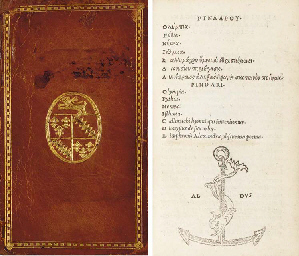PINDAR. Olympia, Pythia, Nemea, Isthmia . Rome: Zacharias Kallierges for Cornelio Benigno, [1515]. 4 (219 x 154mm). With the two blank leaves. Initial and several lines printed in red opening Olympia and Pythia . Woodcut initials and decorative flourishes, Kallierges and Benigno devices on title, a different Kallierges device on final verso. (Some marginal spotting and occasional light dampstaining, annotations washed from .) French late 17th-century olive goatskin, triple gilt fillets around sides, spine tooled in compartments with repeated pallets, gilt turn-ins, gilt edges. Provenance : Nicolaus Hieronymous Mallarius (contemporary inscription on title, motto in Latin and Greek, dated 1521); Jean Masson (1680-1750, French antiquarian and classical scholar, received as a prize for Greek speech from the Master of the College of Navarre, Paris, on 20 August 1699, recorded on front flyleaf). THE FIRST GREEK BOOK PRINTED AT ROME, and the first edition of this work with the Scholia. Kallierges, a native Cretan, had already established two presses at Venice before he arrived in Rome to teach under Janus Lascaris at the newly founded Greek Gymnasium, an academy created at the behest of Pope Leo X. The Greek type Kallierges had used at Venice was left behind, passing to Filippo Giunta, but Kallierges clearly brought with him the punches or matrices for recasting a new fount to print the Pindar. Kallierges printed this first Greek book for Cornelio Benigno, chancellor of Agostino Chigi, on a press at Chigi's villa; it was not until 1517 that Greek books were printed specifically for the Greek Gymnasium. The edition size of the Pindar may have been large as 1000, since on 15 September 1516 Benigno sold the remaining 718 copies to Francesco Calvo, a bookseller from Pavia (Layton, p.324). (See N. Barker, Aldus Manutius and the Development of Greek Script & Type in the Fifteenth Century , New York: 1992, A. Hobson, "The printer of the Greek editions 'in gymnasio mediceo ad Cabillinum montem'," Studi di Biblioteconomia ... in onere di Francesco Barberi , Rome: 1976, pp.331-5; and E. Layton, The 16th-century Greek Book in Italy , pp.318-29.) Adams describes several variants; the present copy has the reading "hV ending the penultimate line of r, A1-2 are unsigned, and A3 has red printing. Hoffman III, p.256; Adams P-1219-21.
PINDAR. Olympia, Pythia, Nemea, Isthmia . Rome: Zacharias Kallierges for Cornelio Benigno, [1515]. 4 (219 x 154mm). With the two blank leaves. Initial and several lines printed in red opening Olympia and Pythia . Woodcut initials and decorative flourishes, Kallierges and Benigno devices on title, a different Kallierges device on final verso. (Some marginal spotting and occasional light dampstaining, annotations washed from .) French late 17th-century olive goatskin, triple gilt fillets around sides, spine tooled in compartments with repeated pallets, gilt turn-ins, gilt edges. Provenance : Nicolaus Hieronymous Mallarius (contemporary inscription on title, motto in Latin and Greek, dated 1521); Jean Masson (1680-1750, French antiquarian and classical scholar, received as a prize for Greek speech from the Master of the College of Navarre, Paris, on 20 August 1699, recorded on front flyleaf). THE FIRST GREEK BOOK PRINTED AT ROME, and the first edition of this work with the Scholia. Kallierges, a native Cretan, had already established two presses at Venice before he arrived in Rome to teach under Janus Lascaris at the newly founded Greek Gymnasium, an academy created at the behest of Pope Leo X. The Greek type Kallierges had used at Venice was left behind, passing to Filippo Giunta, but Kallierges clearly brought with him the punches or matrices for recasting a new fount to print the Pindar. Kallierges printed this first Greek book for Cornelio Benigno, chancellor of Agostino Chigi, on a press at Chigi's villa; it was not until 1517 that Greek books were printed specifically for the Greek Gymnasium. The edition size of the Pindar may have been large as 1000, since on 15 September 1516 Benigno sold the remaining 718 copies to Francesco Calvo, a bookseller from Pavia (Layton, p.324). (See N. Barker, Aldus Manutius and the Development of Greek Script & Type in the Fifteenth Century , New York: 1992, A. Hobson, "The printer of the Greek editions 'in gymnasio mediceo ad Cabillinum montem'," Studi di Biblioteconomia ... in onere di Francesco Barberi , Rome: 1976, pp.331-5; and E. Layton, The 16th-century Greek Book in Italy , pp.318-29.) Adams describes several variants; the present copy has the reading "hV ending the penultimate line of r, A1-2 are unsigned, and A3 has red printing. Hoffman III, p.256; Adams P-1219-21.
.jpg?w=400)














Testen Sie LotSearch und seine Premium-Features 7 Tage - ohne Kosten!
Lassen Sie sich automatisch über neue Objekte in kommenden Auktionen benachrichtigen.
Suchauftrag anlegen